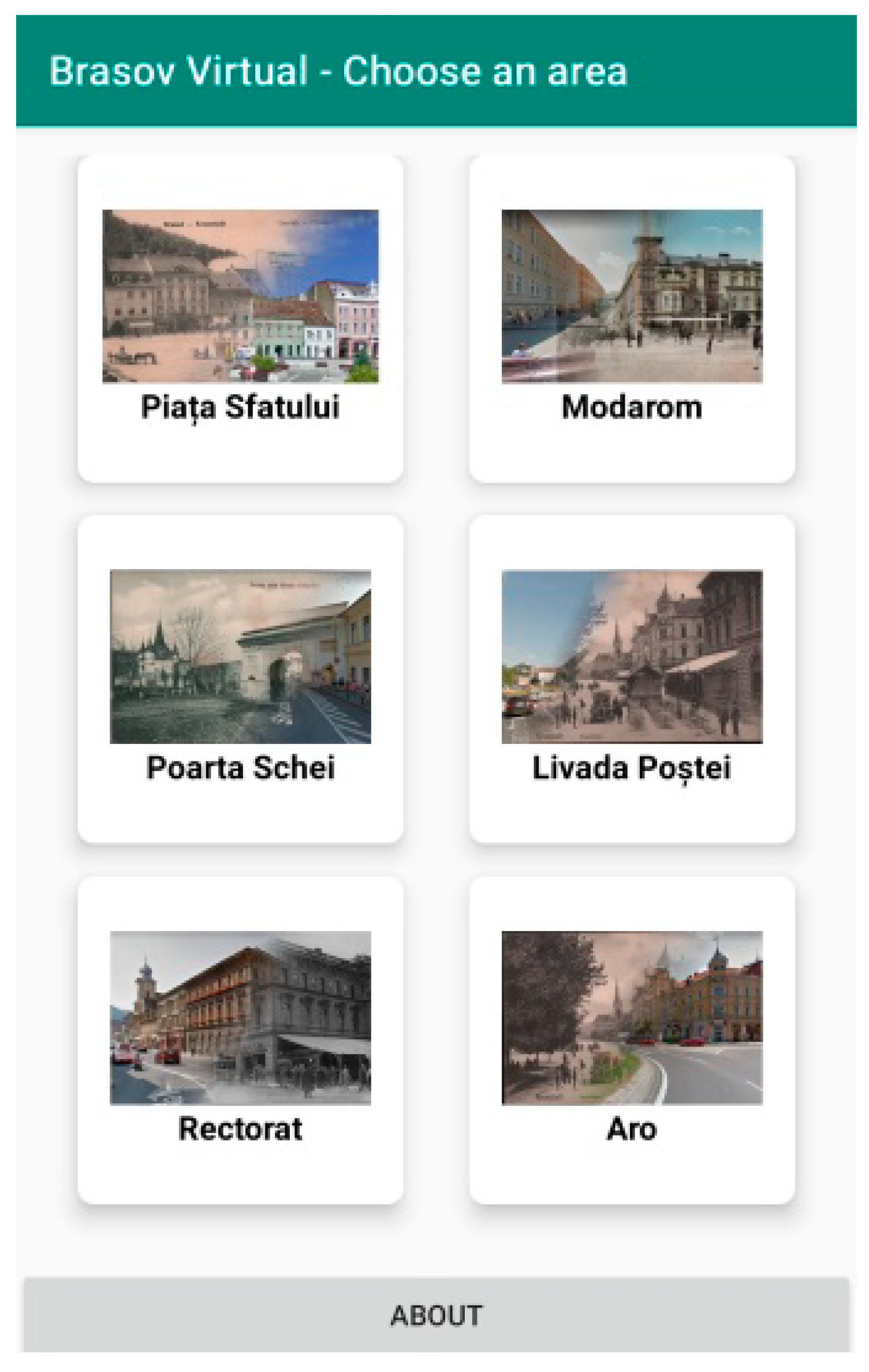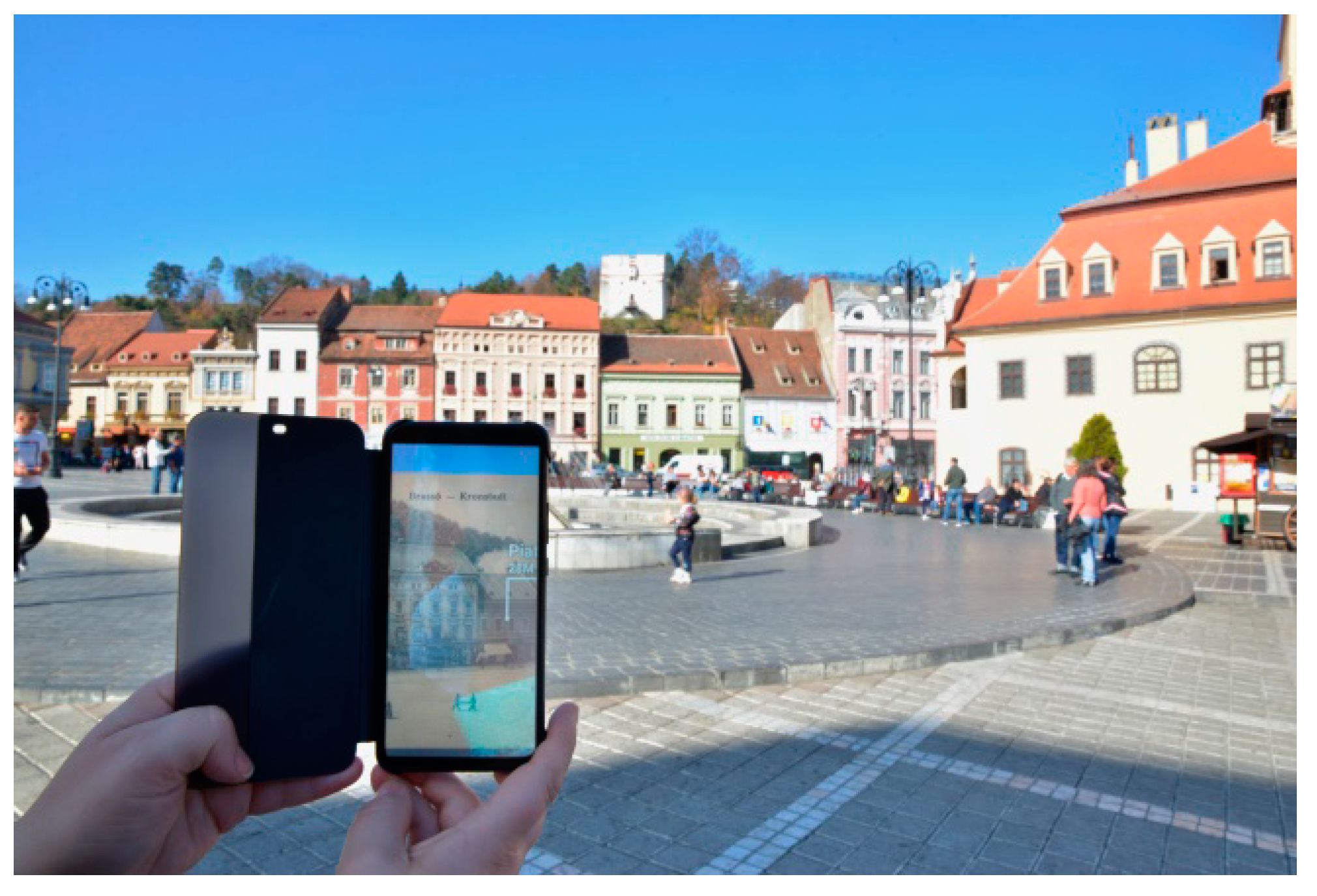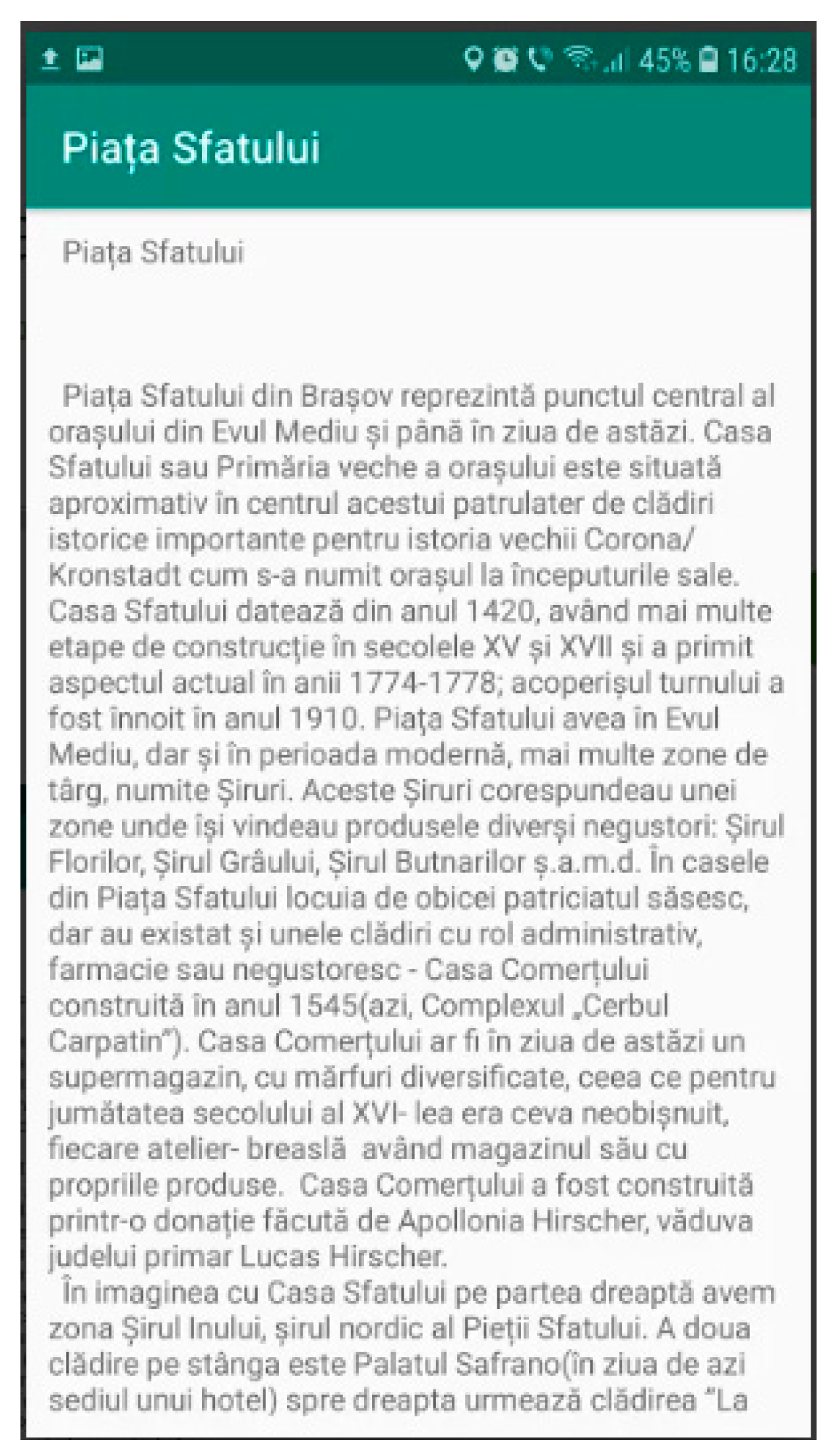Evaluating How ‘Smart’ Brașov, Romania Can Be Virtually via a Mobile Application for Cultural Tourism
Abstract
1. Introduction
2. Literature Review
2.1. Associated Factors of the Smart City Concept and Smart Tourism Destinations
2.2. Virtual and Mobile Applications
- The “Known Facts” approach draws on heritage information that has been substantiated or validated and can be used in the tourism experience to present near-accurate accounts of history; for example, virtual reconstructions of artefacts and cities that visitors can use to obtain information or virtually explore.
- The “Contested Heritage” approach utilizes the unverified stories of local heritage to present a subjective or imaginative interpretation. AR and VR can use this approach to communicate and present cultural stories, myths, or legends that may lack scientific validation.
- The “Combination of Known Facts and Contested Heritage” approach draws on both substantiated and unsubstantiated information to present actual and personalized interpretations or versions of history. For example, virtual recreations of significant events can be developed according to the known facts while incorporating personalized stories or anecdotes of the event.
- The “Alternate Scenarios” approach can draw on the known facts and contested heritage to present alternate realities that may have occurred if certain events in history had resulted in different outcomes.
3. Materials and Methods
3.1. Research Settings—Brașov City Facts and the Romanian Internet Access Analytics
3.2. Case Studies: “Kronstadt—Virtual Reality” Project and “Virtual Brașov” Application
3.3. Research Design and Data Instruments for Evaluating the "Virtual Brașov" Application’s Quality
4. Results
5. Discussion
- Comprehensiveness—in a virtual medium such as the “Virtual Brașov” application, all the touristic objectives, landmarks, and cultural heritage artifacts must be stored, presented, and accessed in one place in relation to the audience’s expectations. In addition, the app should include or use links to places or official websites where one can find more information.
- Accessibility and filtering—data can be filtered by users according to certain criteria, such as name, interest, theme, etc.
- Organization—the data provided in the applications can be organized by the users in their own collections.
6. Conclusions
Author Contributions
Funding
Conflicts of Interest
Appendix A. Translation into English of Figure 3. Sample Description of the “Piața Sfatului” (Council Square) Attraction Area from the “Brașov Virtual” Application Menu
References
- Albino, V.; Berardi, U.; Dangelico, R.M. Smart cities: Definitions, dimensions, performance, and initiatives. J. Urban Tech. 2015, 22, 3–21. [Google Scholar] [CrossRef]
- Letaifa, S.B. How to strategize smart cities: Revealing the SMART model. J. Bus. Res. 2015, 68, 1414–1419. [Google Scholar] [CrossRef]
- Um, T.; Chung, N. Does smart tourism technology matter? Lessons from three smart tourism cities in South Korea. Asia Pacific J. Tour. Res. 2019. [CrossRef]
- Garau, C. Emerging technologies and cultural tourism: Opportunities for a cultural urban tourism research agenda. In Tourism in the City; Bellini, N., Pasquinelli, C., Eds.; Springer: Cham, Switzerland, 2017; pp. 67–80. [Google Scholar]
- Buhalis, D.; Amaranggana, A. Smart Tourism Destinations Enhancing Tourism Experience Through Personalisation of Services. In Information and Communication Technologies in Tourism; Tussyadiah, I., Inversini, A., Eds.; Springer: Cham, Switzerland, 2015; pp. 377–389. [Google Scholar]
- Buhalis, D.; Leung, D.; Law, R. eTourism: Critical information and communication technologies for tourism destinations. In Destination Marketing and Management: Theories and Applications; Wang, Y., Pizam, A., Eds.; CABI: Oxfordshire, UK, 2011; pp. 205–224. [Google Scholar]
- Mistilis, N.; Buhalis, D.; Gretzel, U. Future eDestination Marketing: Perspective of an Australian Tourism Stakeholder Network. J. Travel Res. 2014, 53, 778–790. [Google Scholar] [CrossRef]
- Buhalis, D.; Sinarta, Y. Real-time co-creation and nowness service: Lessons from tourism and hospitality. J. Travel Tour Mark 2019, 36, 563–582. [Google Scholar] [CrossRef]
- Soto-Martin, O.; Fuentes-Porto, A.; Martin-Gutierrez, J. A Digital Reconstruction of a Historical Building and Virtual Reintegration of Mural Paintings to Create an Interactive and Immersive Experience in Virtual Reality. Appl. Sci. 2020, 10, 597. [Google Scholar] [CrossRef]
- World Tourism Organization. Travel and Tourism under Pandemic Conditions Second Review and Preparation Exercise; World Tourism Organization Pubns: Madrid, Spain, 2009. [Google Scholar]
- Chinazzi, M.; Davis, J.T.; Ajelli, M.; Gioannini, C.; Litvinova, M.; Merler, S.; Pastore, Y.P.A.; Mu, K.; Rossi, L.; Sun, K.; et al. The effect of travel restrictions on the spread of the 2019 novel coronavirus (COVID-19) outbreak. Science 2020, 368, 395–400. [Google Scholar] [CrossRef]
- Azuma, R.; Billinghurst, M.; Klinker, G. Special section on mobile augmented reality. Comput. Graph. 2011, 35, vii–viii. [Google Scholar] [CrossRef]
- Mehraliyev, F.; Chan, I.C.C.; Choi, Y.; Koseoglu, M.A.; Law, R. A state-of-the-art review of smart tourism research. J. Travel Tour. Mark. 2020, 37, 78–91. [Google Scholar] [CrossRef]
- European Commision. 2019. Available online: https://ec.europa.eu/info/eu-regional-and-urban-development/topics/cities-and-urban-development/city-initiatives/smart-cities_en#european-innovation-partnership-on-smart-cities-and-communities (accessed on 21 March 2019).
- Fontana, F. The Smart City and the Creation of Local Public Value. In Smart City: How to Create Public and Economic Value with High Technology in Urban Space; Dameri, R., Rosenthal-Sabroux, C., Eds.; Springer: Cham, Switzerland, 2014; pp. 117–137. [Google Scholar]
- Tiagoa, F.; Gil, A.; Stemberger, S.; Borges-Tiago, T. Digital sustainability communication in tourism. J. Innov. Knowl. 2020. [Google Scholar] [CrossRef]
- Angelidou, M. Smart cities: A conjuncture of four forces. Cities 2015, 47, 95–106. [Google Scholar] [CrossRef]
- Buhalis, D. Technology in tourism—From information communication technologies to eTourism and smart tourism towards ambient intelligence tourism: A perspective article. Tourism Rev. 2020, 75, 267–272. [Google Scholar] [CrossRef]
- Dameri, R.P.; Rosenthal-Sabroux, C. Smart City. In How to Create Public and Economic Value with High Technology in Urban Space; Springer: Cham, Switzerland, 2014. [Google Scholar]
- Giffinger, R.; Fertner, C.; Kramar, H.; Meijers, E.; Pichler-Milanović, N. Smart Cities: Ranking of European Medium-sized Cities. Available online: http://www.smart-cities.eu/download/smart_cities_final_report.pdf (accessed on 16 March 2019).
- Harrison, C.; Eckman, B.; Hamilton, R.; Hartswick, P.; Kalagnanam, J.; Paraszczak, J.; Williams, P. Foundations for smarter cities. IBM J. Res. Dev. 2010, 54, 1–16. [Google Scholar] [CrossRef]
- Toppeta, Donato. The Smart City Vision: How Innovation and ICT Can Build Smart, “Livable”, Sustainable Cities. Available online: http://www.thinkinnovation.org/file/research/23/en/Toppeta_Report_005_2010.pdf (accessed on 21 March 2019).
- Nam, T.; Pardo, T.A. Conceptualizing smart city with dimensions of technology, people, and institutions. In Proceedings of the 12th Annual International Digital Government Research Conference: Digital Government Innovation in Challenging Times, College Park, MD, USA, 12–15 June 2011; Association for Computing Machinery: New York, NY, USA; pp. 282–291. [Google Scholar]
- Boes, K.; Buhalis, D.; Inversini, A. Smart tourism destinations: Ecosystems for tourism destination competitiveness. Int. J. Tour. Cities 2016, 2, 108–124. [Google Scholar] [CrossRef]
- Caragliu, A.; Del Bo, C.; Nijkamp, P. Smart Cities in Europe. J. Urban Technol. 2011, 18, 65–82. [Google Scholar] [CrossRef]
- Hollands, R.G. Will the real smart city please stand up? Intelligent, progressive or entrepreneurial? City 2008, 12, 303–320. [Google Scholar] [CrossRef]
- Vanolo, A. Smartmentality: The Smart City as Disciplinary Strategy. Urban Stud. 2014, 51, 883–898. [Google Scholar] [CrossRef]
- Kemp, S. Digital 2019: Global Internet Use Accelerates. Available online: https://wearesocial.com/blog/2019/01/digital-2019-global-internet-use-accelerates (accessed on 27 March 2020).
- Cocchia, A. Smart and digital city: A systematic literature review. In Smart City: How to Create Public and Economic Value with High Technology in Urban Space; Dameri, R., Rosenthal-Sabroux, C., Eds.; Springer: Cham, Switzerland, 2014; pp. 13–43. [Google Scholar]
- Anttiroiko, A.V.; Valkama, P.; Bailey, S.J. Smart cities in the new service economy: Building platforms for smart services. AI Soc. 2014, 29, 323–334. [Google Scholar] [CrossRef]
- Ishida, T. Understanding digital cities. In Digital Cities; Ishida, T., Isbister, K., Eds.; Springer: Berlin, Germany, 2000; pp. 7–17. [Google Scholar]
- Komninos, N. The architecture of intelligent cities: Integrating human, collective and artificial intelligence to enhance knowledge and innovation. In Proceedings of the IEEE 2nd IET International Conference on Intelligent Environments IEEE Xplore, Athens, Greece, 5–6 July 2006; pp. 13–20. [Google Scholar]
- Zardini, A.; Mola, L.; Vom Brocke, J.; Rossignoli, C. The role of ECM and its contribution in decision-making processes. J. Decis. Syst. 2010, 19, 389–406. [Google Scholar] [CrossRef]
- Peris-Ortiz, M.; Bennett, D.R.; Pérez-Bustamante Yábar, D. Sustainable Smart Cities. In Creating Spaces for Technological, Social and Business Development; Springer International Publishing: Cham, Switzerland, 2017. [Google Scholar]
- Sigalat-Signesa, E.; Calvo-Palomaresb, R.; Roig-Merinoa, B.; García-Adán, I. Transition towards a tourist innovation model: The smart tourism destination Reality or territorial marketing? J. Innov. Knowl. 2019, 5, 96–104. [Google Scholar] [CrossRef]
- Boes, K.; Buhalis, D.; Inversini, A. Conceptualising Smart Tourism Destination Dimensions. In Information and Communication Technologies in Tourism; Tussyadiah, I., Inversini, A., Eds.; Springer: Cham, Switzerland, 2015; pp. 391–403. [Google Scholar]
- Open Knowledge. What Is Open? Available online: https://okfn.org/opendata/ (accessed on 18 March 2019).
- Domingo, A.; Bellalta, B.; Palacin, M.; Oliver, M.; Almirall, E. Public open sensor data: Revolutionizing smart cities. IEEE Tech. Soc. Mag. 2013, 32, 50–56. [Google Scholar] [CrossRef]
- Novotný, R.; Kuchta, R.; Kadlec, J. Smart City Concept, Applications and Services. J. Telecom. Syst. Manag. 2014. [Google Scholar] [CrossRef]
- Jasrotia, A.; Gangotia, A. Smart cities to smart tourism destinations: A review paper. J. Tour. Intell. Smartness 2018, 1, 47–56. [Google Scholar]
- Buhalis, D.; Amaranggana, A. Smart Tourism Destinations. In Information and Communication Technologies in Tourism 2014; Xiang, Z., Tussyadiah, I., Eds.; Springer: Cham, Switzerland, 2013; pp. 553–564. [Google Scholar]
- Nechita, F.; Rezeanu, C.-I. Augmenting Museum Communication Services to Create Young Audiences. Sustainability 2019, 11, 5830. [Google Scholar] [CrossRef]
- Kavoura, A. Τwo to Tango: Entrepreneurs and Robots’ Users in Hospitality Service Innovation. In Service Excellence in Tourism & Hospitality: Insights from Asia; Tang, C., Klimkert, D., Thirumaran, K., Eds.; Springer: Singapore, 2020. [Google Scholar]
- Fraune, M.R.; Oisted, C.B.; Sembrowski, C.E.; Gates, K.A.; Krupp, M.M.; Šabanović, S. Effects of robot-human versus robot-robot behavior and entitativity on anthropomorphism and willingness to interact. Comput. Hum. Behav. 2020, 105. [Google Scholar] [CrossRef]
- Sylaiou, S.; Kasapakis, V.; Gavalas, D.; Dzardanova, E. Avatars as storytellers: Affective narratives in virtual museums. Pers. Ubiquitous Comput. 2020. [Google Scholar] [CrossRef]
- Ibañez-Etxeberria, A.; Gómez-Carrasco, C.J.; Fontal, O.; García-Ceballos, S. Virtual Environments and Augmented Reality Applied to Heritage Education. An Evaluative Study. Appl. Sci. 2020, 10, 2352. [Google Scholar] [CrossRef]
- Deaky, B.A.; Pârv, A.L. Virtual Reality for Real Estate—A case study. Conf. Ser. Mater. Sci. Eng. 2018, 399, 24–27. [Google Scholar] [CrossRef]
- Chung, N.; Han, H.; Joun, Y. Tourists’ intention to visit a destination: The role of augmented reality (AR) application for a heritage site. Comput. Hum. Behav. 2015, 50, 588–599. [Google Scholar] [CrossRef]
- Shehade, M.; Stylianou-Lambert, T. Revisiting Authenticity in the Age of the Digital Transformation of Cultural Tourism. In Cultural and Tourism Innovation in the Digital Era; Katsoni, V., Spyriadis, T., Eds.; Springer: Cham, Switzerland, 2020; pp. 3–16. [Google Scholar]
- Bec, A.; Moyle, B.; Timms, K.; Schaffer, V.; Skavronskaya, L.; Little, C. Management of immersive heritage tourism experiences: A conceptual model. Tour. Manag. 2019, 72, 117–120. [Google Scholar] [CrossRef]
- Ivan, I.; Milodin, D.; Zamfiroiu, A. Studierea tipurilor de aplicații mobile și a calității acestora. Rev. Rom. Inform. Autom. 2011, 21, 105–114. [Google Scholar]
- Goel, S.; Nagpal, R.; Mehrotra, D. Mobile Applications Usability Parameters: Taking an Insight View. In Information and Communication Technology for Sustainable Development, Lecture Notes in Networks and Systems; Mishra, D., Nayak, M., Joshi, A., Eds.; Springer: Singapore, 2018; Volume 9, pp. 35–43. [Google Scholar]
- Comino, S.; Manenti, F.M.; Mariuzzo, F. Updates management in mobile applications: ITunes versus Google Play. J. Econ. Manag. Strategy 2018, 28, 1–28. [Google Scholar] [CrossRef]
- Nechita, F.; Demeter, R.; Briciu, V.A.; Kavoura, A.; Varelas, S. Analysing Projected Destination Images Versus Visitor-Generated Visual Content in Brasov, Transylvania. In Strategic Innovative Marketing and Tourism. Springer Proceedings in Business and Economics; Kavoura, A., Kefallonitis, E., Giovanis, A., Eds.; Springer: Cham, Switzerland, 2019; pp. 613–622. [Google Scholar]
- Municipality of Brasov. Bid-Book Brasov 2021—European Capital of Culture. Available online: https://www.capitalaculturala2021.ro/Files/dosare/brasov/Brasov2021_EN.pdf (accessed on 21 March 2019).
- Brasov Attracted 1.3 Million Tourists Last Year and Remains in Second Place in the Top of Their Preferences. Available online: https://www.bizbrasov.ro/2019/02/01/brasovul-atras-13-milioane-de-turisti-anul-trecut-si-ramane-pe-locul-doi-topul-preferintelor-acestora/ (accessed on 25 April 2020).
- Brașov Remains the First County, after the Capital, in Terms of Attracting Foreign Tourists. Available online: https://www.bizbrasov.ro/2018/02/23/brasovul-ramane-primul-judet-dupa-capitala-ceea-ce-priveste-atragerea-de-turisti-straini/ (accessed on 21 March 2019).
- Briciu, V.A.; Nechita, F.; Demeter, R.; Kavoura, A. Minding the Gap Between Perceived and Projected Destination Image by Using Information and Communication Platforms and Software. Int. J. Comput. Methods Heritage Sci. 2019, 3, 1–17. [Google Scholar] [CrossRef]
- Internet World Stats. Available online: https://www.internetworldstats.com/europa.htm#ro (accessed on 21 March 2019).
- Use of Mobile Devices in Romania. EY Romania Study, 2015 Edition. Available online: http://media.hotnews.ro/media_server1/generic_file-2015-09-23-20446381-0-utilizarea-dispozitivelor-mobile-romania-final.pdf (accessed on 3 April 2020).
- DANS Cluster Kick-off Conference Implementing the Digital Agenda in the North Sea Region. Available online: https://www.cui.edu/online/townsend/kickoff-conference (accessed on 13 March 2019).
- Study on Cultural Consumption in Brasov. Available online: https://www.e-cultura.info/studiu-privind-consumul-cultural-la-Brasov (accessed on 21 March 2019).
- Kronstadt—Virtual Reality. Virtual Brasov. Available online: https://www.facebook.com/watch/?v=308767653293819 (accessed on 21 March 2019).
- Brașov Metropolitan Agency. Kronstadt Virtual Reality VR Video 360. Available online: https://www.youtube.com/watch?v=qoSklQSO7FY (accessed on 21 March 2019).
- Brașov Metropolitan Agency—Virtual Brasov Application. Available online: https://play.google.com/store/apps/details?id=aug.bv.com.augmentedbrasov (accessed on 21 March 2019).
- Kavoura, A.; Nechita, F. An Exploratory Study of Online Destination Images via User-Generated Content for Southeastern Rural Transylvania. In Driving Tourism through Creative Destinations and Activities; Kiralova, A., Ed.; IGI Global: Hershey, PA, USA, 2017; pp. 45–66. [Google Scholar]
- Lică, L. Mobile and Social: Ten Best Practices for Designing Mobile Applications. Inform. Econ. 2010, 14, 60–74. [Google Scholar]
- Florek, M. Online City Branding. In City Branding. Theory and Cases; Dinnie, K., Ed.; Palgrave Macmillan: Basingstoke, Hampshire, UK, 2011; pp. 82–90. [Google Scholar]
- Alonso, I.; Bea, E. A tentative model to measure city brands on the Internet. Place Brand. Public Dipl. 2012, 8, 311–328. [Google Scholar] [CrossRef]
- Chelcea, S. Methodology of Sociological Research. Quantitative and Qualitative Methods, 2nd ed.; Economic Publishing House: Bucharest, Romania, 2004. [Google Scholar]
- Hwang, J.S.; McMillan, S.; Lee, G. Corporate web sites as advertising: An analysis of function, audience, and message strategy. J. Interact. Advert. 2003, 3, 10–23. [Google Scholar] [CrossRef]
- Krippendorf, K. Content Analysis, An Introduction to Its Methodology, 2nd ed.; Sage Publications: Thousand Oaks, CA, USA, 2004. [Google Scholar]
- Briciu, V.A.; Demeter, R.; Nechita, F.; Kavoura, A.; Briciu, A. A Proposed Online Platform for Ranking Place Brands Identity Characteristics of Official Tourism Websites. In Strategic Innovative Marketing and Tourism. Springer Proceedings in Business and Economics; Kavoura, A., Kefallonitis, E., Giovanis, A., Eds.; Springer: Cham, Switzerland, 2019; pp. 755–762. [Google Scholar]
- Briciu, V.A.; Briciu, A. Opportunities and Limitations of Online Place Branding Strategies in a Circular Economy Context. In 6th SWS International Scientific Conference on Social Sciences 2019, Proceedings of the Economics & Finance, Business & Management; STEF92 Technology Ltd.: Sofia, Bulgaria, 2019; Volume 6, Issue 2, pp. 219–232. [Google Scholar]
- Kolbe, R.H.; Burnett, M.S. Content-analysis research: An examination of applications with directives for improving research reliability and objectivity. J. Consum. Res. 1991, 18, 243–250. [Google Scholar] [CrossRef]
- Iluţ, P. Qualitative Approach to Sociohuman; Polirom Publishing House: Iasi, Romania, 1997. [Google Scholar]
- Kavoura, A.; Sylaiou, S. Effective cultural communication via information and communication technologies and social media use. In Advanced Methodologies and Technologies in Media and Communications; IGI Global: Hershey, PA, USA, 2019; pp. 377–390. [Google Scholar]
- Baccarne, B.; Schuurman, D.; Mechant, P.; Marez, L.D. The role of Urban Living Labs in a Smart City. In Proceedings of the XXV ISPIM Conference—Innovation for Sustainable Economy & Society, Dublin, Ireland, 8–11 June 2014; pp. 1–14. [Google Scholar]



© 2020 by the authors. Licensee MDPI, Basel, Switzerland. This article is an open access article distributed under the terms and conditions of the Creative Commons Attribution (CC BY) license (http://creativecommons.org/licenses/by/4.0/).
Share and Cite
Briciu, A.; Briciu, V.-A.; Kavoura, A. Evaluating How ‘Smart’ Brașov, Romania Can Be Virtually via a Mobile Application for Cultural Tourism. Sustainability 2020, 12, 5324. https://doi.org/10.3390/su12135324
Briciu A, Briciu V-A, Kavoura A. Evaluating How ‘Smart’ Brașov, Romania Can Be Virtually via a Mobile Application for Cultural Tourism. Sustainability. 2020; 12(13):5324. https://doi.org/10.3390/su12135324
Chicago/Turabian StyleBriciu, Arabela, Victor-Alexandru Briciu, and Androniki Kavoura. 2020. "Evaluating How ‘Smart’ Brașov, Romania Can Be Virtually via a Mobile Application for Cultural Tourism" Sustainability 12, no. 13: 5324. https://doi.org/10.3390/su12135324
APA StyleBriciu, A., Briciu, V.-A., & Kavoura, A. (2020). Evaluating How ‘Smart’ Brașov, Romania Can Be Virtually via a Mobile Application for Cultural Tourism. Sustainability, 12(13), 5324. https://doi.org/10.3390/su12135324





